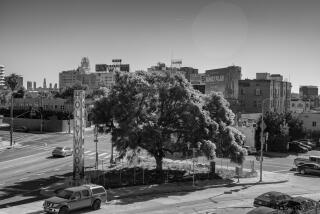100 ginkgo trees, a Japanese grower’s gift symbolizing the cultivation of global harmony, are being choked by methane gas beneath an Oxnard golf course : Hostile Ground for Peace Gift
- Share via
They were never formally linked as sister cities, but Oxnard and the Japanese town of Ebino were to be forever joined at the ginkgo.
However, the relationship has failed to fully take root.
Many of the 100 Asiatic ginkgo trees donated last year by an Ebino tree farmer to the city of Oxnard have died, perhaps the victims of methane gas bubbling up from the old landfill beneath the River Ridge Golf Course.
“Their condition, I’m very sorry to say, is poor,” said Oxnard Mayor Nao Takasugi. “For some reason, they didn’t do very well.”
Most trees have a tough time flourishing on the new golf course, said Don Marquardt, Oxnard’s acting parks development supervisor. “One of the problems we’ve consistently had is the methane gas being generated by the landfill. And the landfill was covered in very poor soil. Trees there generally are not in the most perfect of conditions.
A Generous Gift, but . . .
“There was no study beforehand of whether these were the right trees for the situation,” he said. “In hindsight, one would look at it as a very generous gift, but had the person giving it known all about where the trees were going to be planted, maybe he would have given another kind of tree.”
Yoshisada Ozono, a 73-year-old Japanese war hero chose Oxnard for his beneficence because his daughter, Kiriko Tomimitsu, who last month moved to Camarillo, had lived there for 15 years.
A prosperous grower whose operation is used as a model by the Japanese government, Ozono cleaned the saplings’ roots and wrapped them in absorbent paper for the trip. He even brought along a reporter for a regional newspaper on Kyushu, Japan’s southernmost island, to chronicle the cultivation of global harmony.
“This gift is my way of honoring the quest for world peace,” Ozono told Oxnard officials as he blessed the trees in an ancient Shinto rite during a ceremony at the golf course. “Please protect my trees.”
At about the same time, Ozono got schoolchildren in Ebino, a city of about 28,000, to plant 230 of the young trees along a roadside in mountainous Kirishima National Park. Each of the trees bore a tag with the name of the student who was to be responsible, not only for planting it, but for returning to tend it, pray over it and watch it grow.
Beside the road, Ebino officials unveiled a billboard-sized wooden sign that says “Oxnard Road” in Japanese and English. An outline map of the United States also appears on the sign, emblazoned with a Japanese inscription that concludes: “This road will blaze a trail to Oxnard.”
The fifth- and sixth-graders from the Uwae School wrote letters in Japanese intended for their counterparts in Oxnard. “The letters were very heart-warming,” Takasugi said. “They dwelt mostly on the trees in Oxnard doing well, how they were hoping to see them one day.”
The mayor, who had the letters translated six months after their delivery, has channeled them to elementary schools in Oxnard. He said students might want to focus their responses on the generosity of the gift and on the comparative health of some cherry trees in Oxnard, which also had come from Japan.
Cone-Bearing and Deciduous
Native to China, ginkgoes can grow as tall as 30 feet. They are one of the few species that is both coniferous and deciduous, with fan-shaped leaves turning gold and dropping off every autumn.
With watering, they ordinarily thrive in Ventura County, said Jim Downer, an environmental horticulture specialist for the Ventura County farm and home advisers’ office. “The ginkgo is one of the most insect- and disease-resistant trees there is,” he said. “Under normal conditions, I wouldn’t expect to lose them.”
Neither did Ozono’s daughter, Kiriko Tomimitsu, nor her husband, Harry Tomimitsu, a nurseryman who tends fields of baby’s breath near Somis.
Kiriko Tomimitsu went to see the trees once a week after her father left, but cut her visits off after a few months. “It hurts too much,” she said. “So many have died.”
More to Read
Sign up for Essential California
The most important California stories and recommendations in your inbox every morning.
You may occasionally receive promotional content from the Los Angeles Times.














